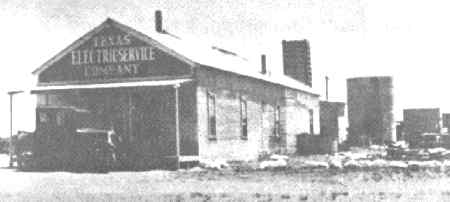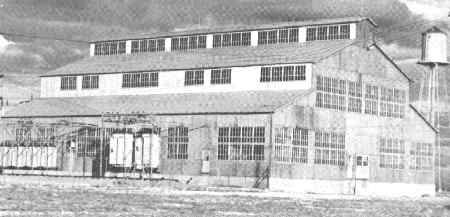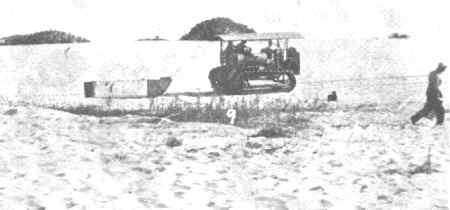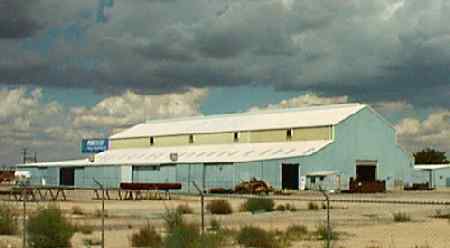
Generating plant, build of much-used equipment, and office established in Crane in 1927 to meet urgent need for electricity in the new oil fields and in the growing town.

After the four Electric Bond and Share operating subsidiaries had been combined into one corporate structure, Texas Power & Light Company continued to provide management and staff functions. Named to head the new company were W. B. Head, chairman of the board; C E. Calder, president; and John W. Carpenter, vice president and general manager. All continued to serve as officers of Texas Power & Light Company, which during the previous 14 years had developed and interconnected the various local companies as their securities were acquired by the holding company.
J. B. Thomas, who became chief engineer of Texas Power & Light Company in 1920, was the man most closely associated with physical development of the electric properties of all four of the companies, up to and including the last major project prior to formation of the first Texas Electric Service Company. This was the construction of a 28-mile, 33,000 volt transmission line from Sweetwater to Snyder.
Only a few months after the new company was organized, the discovery of rich oil deposits in the Chalk Field south of Big Spring and soon afterward in the area west of there completely changed the requirements for electric service in the region that formerly had been devoted largely to cattle raising and some dry farming. Towns and cities expanded at an almost unbelievable rate, and many new communities sprang up, requiring instal- lation of power plants, new and larger transmission lines and other facilities.
With discoveries in the Chalk field, electric service contracts in the new oil field required the addition of a 500 horsepower diesel generating unit in the Big Spring plant, the construction of a 66,000 volt line from the plant to the field, and many miles of 12,500 volt line. This construction was rushed to completion in 30 days, as specified in the contract, and a short time later another 500 horsepower unit was installed to serve additional load.
While work was under way on the Big Spring additions, wildcat wells near Wink and Crane blew in, spewing oil over derrick tops and presaging vast new oil field developments. Water was scarce and fuel suitable for use in the engines customerily used in oil fields was severely limited. Pipeline pumping stations, casing head gas plants and refineries were being erected and electric power in large quantities was demanded. It was apparent that a strong transmission system, solidly interconnected with neighboring utilities was necessary to carry large blocks of power and to fully utilize all available generating capacity because local plants were unable to cope with oil field demands.
The company in March, 1927, began purchasing and developing electric properties in other West Texas communities. These were to be tied into the area-wide transmission network. The first of these companies was in Midland, but it also served Odessa and Stanton.
The Midland Light Company had been established in 1907, and in 1916 was purchased by the Southern Ice and Utilities Company. When the company was acquired ten years later by the first Texas Electric Service Company it was headed by C. W. Dawley, president, and C. A. Fullinwider, vice president. The Midland company's generating plant consisted of a 525 kilowatt diesel engine, and lines had been built to serve customers in Odessa and in Stanton. Until that time, efectricity had not been available in Odessa, but in Stanton, formerly known as Marien- feld, a plant was being operated by James Otis Blackerby. Blackerby had built the plant about 1911 after moving there from Jack County. His plant served a few residences and stores, the bank, and a barber shop. According to the Stanton Reporter issue of January 13, 1972, which reported Blackerby's death, Along about 9 p.m., Blackerby would blink the lights. This was a signal to go to bed, because he was fixing to cut the power."
Also in March, 1927, the company started construction of the first power plant in Crane, which was growing rapidly because of the nearby oil field developments. Two 100 horsepower Fair- banks-Morse two-cycle upright engines, and a 25 horsepower engine, all of which had seen service in other locations, were installed in the plant. All the machinery was "well worn out" when installed, according to E. N. Beane, the plant operator, as quoted in the Crane News of August 10, 1972.
About the 25 horsepower engine, Beane said, "I do not know if Noah had electric power in the Ark or not, but if he did, I feel sure it was this engine and generator."
Beane and another local man were recruited to operate the plant. "I had been employed by a grocery firm from the fifteenth of February until I resigned to work at the plant," Beane said. About two weeks before the plant was completed, they asked me to take the engineer job. My new job would be to operate the plant along with a man by the name of Buster Biggs. Just the two of us operated the plant, working 12-hour shifts, seven days a week. They boxed off one corner of the power plant for an office. Clarence Wiggs, an ex-school teacher from Pecos, was the first local manager."
In commenting on the "worn out" machinery installed in Crane-and in other instances in the West Texas area during those years, J. B. Thomas explained that before the transmission lines to new and growing towns could be built service was pro- vided on a temporary basis from hastily constructed and more-or-less portable engine generator plants. The equipment was moved from town to town as each, in turn, was tied into the transinission system. This was a long-standing practice during the formative years of the West Texas system, as well as that of Texas Power & Light Company some years earlier.
"The system grew in stages as business grew, and loads grew, and generating capacity grew," Thomas recalled. "We kept up with the growth as best we could, moving little diesel units from situations that had grown too large for them to other places where they were useful and could start over again.

Generating plant, build of much-used equipment, and office established in Crane in 1927 to meet urgent need for electricity in the new oil fields and in the growing town.
During the time the local properties in West Texas were being acquired and developed, the company transmission system was being strengthened and extended westward from the Eastland area to take better advantage of the generating capability in the various towns and of the power plant on the Leon River. Generating capability of the Leon plant had been increased to 30,500 kilowatts and an agreement had been reached with West Texas Utilities Company for construction of a 132,000 volt line across its territory between Eastland and Sweetwater. The next segment of the transmission line was between Sweetwater and Big Spring and it had been converted from 33,000 to 60,000 volts. The Eskota switching station was enlarged at this time to tie together the new 132,000 volt line and the lines in the Sweet- water area.
The 132,000 volt line then was extended to Big Spring and to a new switching station, almost a duplicate of the one at Eskota, near Sweetwater; and the distribution system serving Big Spring and the growing oil field, refinery and pipeline pumping stations was strengthened. The Big Spring development materially increased the capacity of the Big Spring switching station as a load center, and a new 66,000 volt transmission line was built from the Chalk Substation to Crane. This line completed two-way service to Chalk and Crane oil fields and provided capacity in the area for oil related loads At the same time, a 66,000 volt line was built from Big Spring through Midland to Odessa. This, in effect, connected the oil engine plants on the west end of the system with the power plant on the Leon River.
While the Big Spring-Odessa line was being built, work also was under way on construction of a power plant in Odessa. Three 500 horsepower diesel units were installed in this plant, which was of sheet iron construction and located adjacent to the Texas Pacific Railway tracks where the company had purchased 47 acres. A switching station and substation were built beside the plant as was a village, consisting of a number of homes, for plant employees. This was a practice also followed at the Leon plant, and later at other plants in areas where housing was not available nearby.
The next step in transmission line construction was extension of the 66,000 volt line from Odessa to Crane, a project under way late in 1927. In November of that year, J. B. Thomas narrowly escaped death in a crash of a small airplane at takeoff near Odessa to survey the terrain between there and Crane.
The plane was a 12-cylinder Dellavilland owned by Fairchild Aerial Survey, Inc., of Dallas and formerly had been used by the post office department to fly airmail out of Rock Springs, Wyoming. Mail had been carried in a compartment in front of the pilot. Fairchild had modified the mail compartment of the plane to carry a passenger. On this particular mission, the passenger in the front seat was J. B. Thomas. The pilot was L. H. Luckey. Thomas recalled later that the last thing he remem- bered of the takeoff was an orange, which was in the front seat beside him, rolling to one side. The next thing he recalled was regaining consciousness in a Big Spring hospital.
The accident occurred when Luckey gunned the old plane down ,the field and, noticing two trees, one on either side of the plane's path, pulled the right wing up to avoid the tree on the right. As the right wing came up, the left wing dipped and hit the tree on the left side, spinning the plane around. Later, it often was pointed out that the plane Thomas was in hit the "only two trees in West Texas."
In reporting on what happened immediately after the crash, Luckey said, "I was afraid the plane would burn, so my first reaction was to get Mr. Thomas out."
One of Thomas' legs hit the bulkhead and the other went through it and was pinned under the motor when it dropped, causing a severe fracture and deep burns.
A doctor at Odessa wrapped Thomas' legs in adhesive tape and John Lancaster, president of the Texas & Pacific Railway, furnished a special baggage car to transport him to Big Spring.
At the time of the crash, Thomas had been married seven years and Mrs. Thomas was at home in Dallas. The first report she received was that her husband had been killed in the crash; however, this was corrected and she hurried to Big Spring. Rushing into the hospital, she asked, "Where's Papa?"
The nurse told her that she could hear him swearing in a room behind a nearby door. Mrs. Thomas reacted quickly, "No," she said, "that's not him . . Papa doesn't swear!" But a moment later when she opened the door and found him, just as the nurse said she would, there was no refuting the evidence on either count.
Thomas remained in the hospital about six months as an aftermath of his part in the pioneering aerial reconnaissance for transmission lines in the sandy West Texas country.
"But it was worth it," he reflected years later. "You learn a great deal from the licks you get. A fellow who has been moving all his life at a high rate of speed had to be stopped once in a while-you know, it's good for him. With a plaster cast from ribs to your toes for a few months, you begin to reflect. It occurs to you that probably you're not the most important person in the universe, and that other people can do things."
Soon afier discovery of oil in the Crane-Odessa fields, a new oil field was brought in near Kermit in Winkler Couniy, and it began to surpass the others in magnitude. The new town of Wink grew rapidly into a thriving city, and towns along the railroad-such as Monahans and Wickett-were extended electric service. To serve the Winkler County oil fields, 66,000 volt lines were built from Odessa to Wink, through Monahans and Wickett and, another by way of Midway.
Construction of the 66,000 volt transmission line through the sandy West Texas country was a race against time to provide critically needed electric power as drilling rigs dotted the area and nearby communities swarmed with newcomers. Scores of men made up the construction crews. They used almost every kind of available equipment-trucks, wagons, horses and tractors. In some areas, tops were blasted off the sand dunes to help trucks get through. At times trucks were fitted with canvas or rubber belts around their dual wheels to give them traction in the powdery sand. Some equipment was hauled on slides pulled by tractors. A crew could string about five miles of line a day, with a crew of drillers preceding by about one day. Pole setters and wire stringers followed in succession.

Construction of the Odessa-Wink 66,000 volt transmission line in 1927 through the sand dunes of Winkler County involved many difficulities. Tractors and sled were useful in moving supplies. Surprisingly enough, in some instances the job was complicated by underground water encountered at a depth of about six feet.
Other towns in West Texas that were provided service during the 1926-1929 period included Forsan in the Chalk Oil Field; Andrews where oil had also been discovered; and in Grandfalls and Royalty where a small plant was built to serve both communities.
During the rapid expansion in West Texas, the Wichita Falls and Eastland areas also were active, and in order to further strengthen the power system, a 60,000 volt line was built through Breckenridge and Holliday. This line was intercon- nected at the Wilbarger County line with the neighboring West Texas Utilities Company system. Shortly thereafter the 22,000 volt loop from Wichita Falls through Burkburnett, Electra and Iowa Park was converted to 33,000 volt operation, and sub- stations in Wichita Falls and in the other towns were changed to care for the growing load.
The electric plant in Bowie was acquired in 1927 from the Texas Public Utilities Corporation which continued to own the Weatherford properties but later arranged for Texas Electric Service Company personnel to manage the operations there. Also in 1927, the company bought the electric plant in the small town of Desdemona, south of Eastland. Desdemona then was being served under a franchise granted Walter E. Lamm and Guy McGee. Property consisted of a small engine plant and a distribution system. Also acquired was a 6,600 volt transmission line, constructed to Desdemona in 1920, when the Oil Belt Power Company's Leon-Dublin line was completed to Gorman. Other towns in the Eastland area extended service included Olden and Carbon, which were served from an oil field distribution system, and South Bend in Young County.
By 1929, with expansion of the transmission system of the first Texas Electric Service Company, service had been improved and more power had been made available throughout the area. Many small towns, some of which previously had only small isolated power plants, were tied into the system, and more dependable electricity, at considerably lower cost, had become available. The company now was serving customers in 52 cities, towns, and rural communities, and providing power in a number of oil fields. Generating capability was 49,679 kilowatts, consisting of about 43,000 kilowatts in steam electric generation and 6,500 kilowatts in diesel plant. The transmission system totaled 1,521 miles in length. The time had come, as result of the progress that had been made by the company and by the area it served, to combine the operations in West Texas and those headquartered in Fort Worth. This would be a logical consolidation, one promising more load diversity, financial stability and increased efficiency, factors that in the long run should benefit customers by making possible better service at lower rates throughout the entire area served.
Photo courtesy: "And Work was made Less" [ A brief history of Texas Electric Service Company ] by Vance Gillmore, 1976.

Electrification History from "Odessa, 100":
Odessa's streets were dark in the early days-unless the full moon was out. Young people learned their lessons and read the family Bible by kerosene lamplight. The lamp was placed near a window for family members who went out at night. The last person to bed had to blow it out.
Most merchants closed at sundown. The saloons stayed open by using kerosene lamps. Later, some used mantled gasoline lamps. The mantle was a thin webbed, chemically prepared, incombustible network hood for a gas-jet. When the jet was lighted, it became incandescent and gave a brilliant light. They were used in doctors' offices as well.
Lanterns were used on vehicles, hung in the rafters for barn dances, public affairs and prayer meetings.
Cowboys had only their campfires for light. Torches were used by search parties.
"Make-do" lights could be made by soaking a wick in hot tallow, then cooling and redipping it. The tallow dips were then plunged into cold water and shaken to "feather" them which prevented dripping.
The Midland Light Company made electricity available in 1907. The company served customers both here and in Stanton with a 525 kilowatt diesel engine. (This would not meet today's requirements for most individual homes.)
Odessa Light and Ice Company moved here in January 1908. C. D. Fly bought the business from E.G. Durham for $2,500 in 1912. It was repossessed a year later and sold at public auction to R. N. Henderson for $605. A short time later, Henderson sold the plant to Odessa Light and Power Company for $1.00 plus forty shares of their stock.
There wasn't any electricity during the daytime. The "light plant" wasn't started up until dusk each evening. In 1919, however, the company proudly announced that the power would be on for a "couple of hours" on Thursday afternoons, so the ladies could use their electric irons.
The company further exhibited their public-spiritedness by installing four 100-watt bulbs to light Grant Street.
The Texas Electric Company bought the franchise in 1927. The first office was located across the street from the post office on Texas Street. TESCO's first power plant had three diesel generating units and was located on South Dixie.
TESCO's modern office building at 6th and Lincoln was constructed at a cost of $585,000 in 1964. They have two switching yards and many miles of transmission line.
On January 1, 1967 there were 29,965 electric customers; in 1981, 48,650. Lights, appliances, heat and air conditioning are taken for granted today. Things weren't so convenient or good in early Odessa.
The pioneers hung wet tow sacks in their windows and cooled their drinking water in a wooden bucket which was wrapped with tow sacks and kept wet. It usually hung on the porch with a long-handled tin dipper. Milk was kept in a "milk-cooler" shed which held several inches of water.
One pioneer ranch wife sent her husband for milk after dark, He fumbled around with his hand in water feeling for the milk. Finally he yelled back, "Is that milk in something or is it just loose?"
Courtesy: Author; John Ben Shepperd & Wanda Snodgrass
Tim O'Reilly Illustrator.
Exchange Club Publication, July, 1981.
ODESSA 100; Read this book today!